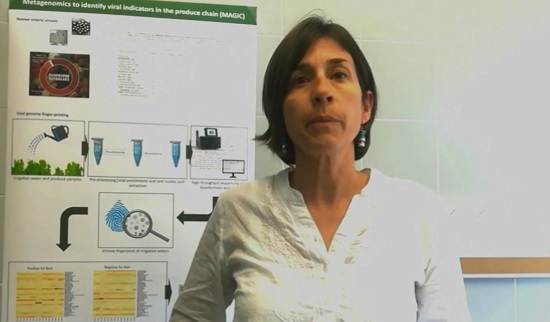
Although viruses may be responsible for roughly half of all foodborne illness outbreaks, current testing methods are difficult because of the time, complexity and cost involved.
- Current testing for human pathogen viruses in produce is costly, complex and time consuming.
- Researchers are using next-generation sequencing to try to find organisms that could reliably indicate the presence of viral pathogens.
- If an indicator is found, it may provide the basis for development of a quick, easy-to-use assay for the produce industry
Gloria Sánchez-Moragas, Ph.D ., hopes to change that by identifying viral indicators using metagenomics -- next-generation tests that examine the genetic content of an entire microbial community found in a sample. Should she be successful in finding an indicator, Sánchez-Moragas said it may provide a basis on which an assay could be developed for the produce industry.
"If we're able to find a surrogate, the next step would be to develop a quick, easy method to detect the indicator," said Sánchez-Moragas, a food microbiologist with the Institute of Agrochemistry and Food Technology of the Spanish Council for Scientific Research in Valencia, Spain.
But she admits it will be a challenge. "Maybe we can get an indicator that, even if it's not predicting 100 percent of the time, still may be reasonable to consider by the industry," Sánchez-Moragas said. "We did get millions of (genetic) sequences that are going to build useful information, so I hope we can get a lot of insight into the use of indicators for viruses."
Although the amount of data to analyze is huge it is exciting to try to see, even if it's not a 100 percent consensus, if we can get a consensus for which one is the best (indicator) and can it be applied by the industry."
Joining her as co-principal investigator in the project, titled "Metagenomics to identify viral indicators in the produce chain," is Jesús Rodriguez Diaz, Ph.D., with the University of Valencia. He brings with him expertise in metagenomics analysis. Post-doctoral researcher Alba Pérez Cataluña Ph.D., also is involved.
The project focuses on irrigation water and human fecal matter, which are the main produce transmission routes for human enteric viruses. Testing for these pathogens frequently relies on the presence of bacterial indicators. Yet they may not accurately reflect a viral presence, Sánchez-Moragas said. "Several studies show that fecal coliforms are not good indicators for viruses because fecal coliforms are bacteria, and bacteria are less resistant than viruses," she said. "We've had situations where fecal coliforms weren't present but viruses were present and caused an outbreak." Even within the scientific community, she says, there is not a strong consensus about whether specific bacteriophages -- viruses that infect bacteria -- are reliable indicators of human pathogenic viruses.
Standard genomic sequencing of a virus involves a complex multi-step procedure to isolate and then amplify genetic material from one organism before tests akin to molecular fingerprinting can be run. Specific equipment and trained personnel are required to perform the analysis, and these types of tests are mainly used for research.
Where Sánchez-Moragas' project differs is it uses metagenomics to try to analyze and separate all of the genetic material found in an entire irrigation water, human fecal or produce sample. The key to metagenomics is in sample preparation, and these researchers already have developed a protocol.
"You don't culture your pathogen," she said. "You produce the sequences of all of the genomes."
From there, the researchers will try to correlate the presence of indicators or bacteriophages to the presence of human pathogenic viruses.
They will also validate the metagenomic testing method by comparing the results to those produced from real-time PCR, a type of individual genetic fingerprinting considered an industry standard.
With much of the laboratory work already completed, Sánchez-Moragas said the laborious job of analyzing the genetic sequences begins, and that's where Pérez-Cataluña will be involved. "This is the most difficult task of the project, because once we have set the method, now what we're doing is analyzing the millions of sequences," Sánchez-Moragas said. "We need to see if we find differences between the positives and negatives and apply standard analysis to verify all of these results."

